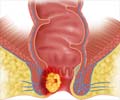Researchers have built the first functional anal sphincters in the laboratory,

Sphincters are ring-like muscles that maintain constriction of a body passage. There are numerous sphincters in the human body, including those that control the release of urine and feces. There are actually two sphincters at the anus – one internal and one external. Fecal incontinence is the result of a weakened internal sphincter.
There is a high incidence of weakened internal fecal sphincters in older adults; and women who have had episiotomies during childbirth can also be affected. "Many individuals find themselves withdrawing from their social lives and attempting to hide the problem from their families, friends, and even their doctors," said Bitar. "Many people suffer without help."
Current options for repair of the internal anal sphincter include grafts of skeletal muscle, injectable silicone material or implantation of mechanical devices, all of which have high complication rates and limited success.
To engineer an internal anal sphincter in the laboratory, the researchers used a small biopsy from a human sphincter and isolated smooth muscle cells that were then multiplied in the lab. In a ring-shaped mold, these cells were layered with nerve cells isolated from mice to build the sphincter. The mold was placed in an incubator for nine days, allowing for tissue formation. The entire process took about six weeks.
Numerous laboratory tests of the engineered sphincters, including stimulating the nerve cells, showed normal tissue function, such as the ability to relax and contract. The sphincters were then implanted just under the skin of mice to determine how they would respond in the body. Mice with suppressed immune systems were selected so that there would be no issues with rejection.
Advertisement
"The engineered sphincters were physiologically similar to native tissue," said Bitar. "This takes us one step closer to realizing the goal of using a patient's own cells to engineer a replacement sphincter in the lab."
Advertisement
"Our latest advance, a sphincter engineered with muscle and nerve cells, will allow us to 'connect' the engineered tissue with nerve pathways in the intestine," said Bitar.
Bitar's group will continue the research in more advanced research models. The ultimate goal is to harvest both muscle and nerve cells from a patient, build a pre-wired sphincter in the lab, and implant it back in the same patient. Using the patient's own cells would eliminate the risk of rejection.
"While we have numerous challenges to meet, we have crossed a major hurdle," said Bitar. "This proof of concept research suggests that this strategy may be useful for treating a variety of neuromuscular conditions of the intestine. In addition, it could potentially be applied to other diseases of sphincter muscles, including urinary incontinence."
Source-Eurekalert










